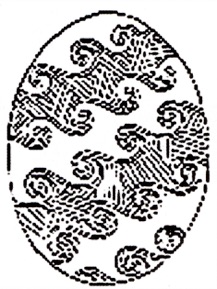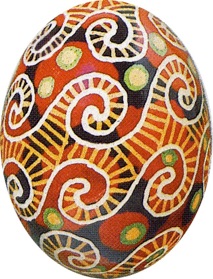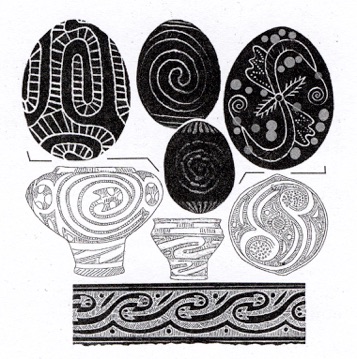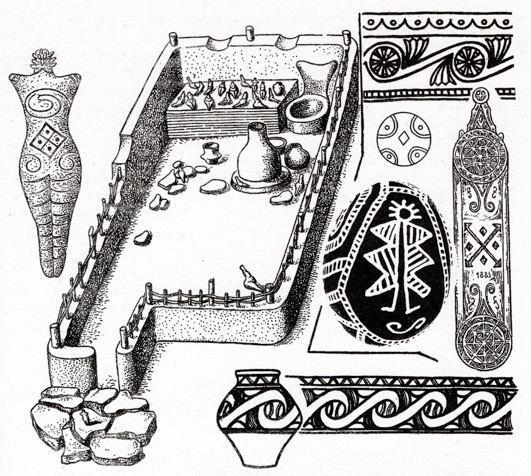Ancient origins

No can state with any certainly when Ukrainians began making pysanky. If you surf the web, you will find references to our neolithic ancestors creating pysanky in caves and other such flights of the imagination. But it is all just conjecture...with perhaps an element of fantasy.
The archeological record does not help us here. No eggshells have survived from Neolithic1 times in Ukraine or the rest of Europe. Incised ostrich eggshells have been excavated in archeological digs in Egypt and Nubia, but these eggs had a much thicker and stronger type of shell, and the arid climate was much more amenable to their preservation. The Trypillians (a late neolithic culture, 5500-2750 BC) created pottery which has survived to modern times, and one of their more common motifs was the "dissected egg2."
According to T.O. Konoval, there exists a single example of a Trypillian ceramic pysanka (at the L’viv National Museum)–a “trinket” with beads inside. The decoration is that of a bezkonechnyk/wave motif:

Compare this to a traditional pysanka from Kosmach3, in Carpathian Ukraine:

It almost exactly a mirror image of the Trypillian ceramic pysanka. Yuriy Shylov, in his book, «Праслов’янська Аратта» (Protoslavic Aratta) gives these comparisons of Trypillian motifs and traditional pysanka designs:

In excavations from the Bronze age4, cultic eggs (but not pysanky) have been found in archaeologic digs of graves on Ukrainian territory. It is thought that the status of the egg as a symbol of rebirth was the reason for its inclusion in burials. Stone and clay eggs were created for similar purposes in the late Bronze age.
And, prior to the X century BC, there were numerous ovoid (egg-shaped) buildings constructed in the Ukrainian heartland. One is pictured on this page. These were thought to have ritual functions.
Did our ancient ancestors create pysanky? A few scholars believe they might have. The pysanky they made would not be like the “Trypillian” pysanky currently created and marketed by pysanka artists–those merely adapt Trypillian pottery designs (and pottery colors of white, black and brick) to an egg. Actual ancient pysanky would have been created for ritual purposes, and would have been made similarly to traditional Ukrainian pysanky (like the ones pictured above). They would have been made using natural dyes and beeswax5, and would probably have used some of the basic motifs that have been passed down from Trypillian times. But their creation and existence is mere conjecture.
Palamarchuk and Andriyevs’kiy illustrated and catalogued these ancient motifs in their book «Зорі Трипілля» (Stars of Trypillian). They also came up with imaginative names and meanings for them, grounded more in imagination than in fact. Many of the symbols are still in use today in traditional Ukrainian arts, including pysankarstvo. And many of the symbols have been assigned by them similar, if not the same, meanings that they are thought to have had in early pysankarstvo. A few examples:

«Дерево Життя»
Tree of Life

«Дощ»
Rain

«Водя Життєдайна»
Life-giving water

«Спіраль часу»
Spiral of Time

«Хвиля»
Wave
Quite frankly, these are very basic symbols and the meanings are extrapolations of more recent ones. (The rest of the symbols and their “translations” can be found in the Trypillian Symbol section.)
It is also interesting that the areas with the most diverse and locally varied pysanka designs are in Western Ukraine, in the same areas that have the largest concentrations of Trypillian sites. This would be expected if the art form had originated here and later spread to other regions, but is perhaps better explained by the fact that these regions were under Soviet hegemony a much sorter times and thus didn’t have their folk culture eradicated to nearly as great an extent.
__________
-
1."New" Stone Age, was a period in the development of human technology, beginning with the rise of farming, which produced the "Neolithic Revolution" and ending when metal tools became widespread in the Copper Age (chalcolithic) or Bronze Age or developing directly into the Iron Age, depending on geographical region. In Ukraine this corresponds to the Trypillian period of history. (Wikipedia)
-
2.According to Vira Manko “Ukrainian Folk Pysanka,” in the Ukrainian-language version of The Ukrainian Folk Pysanka, this was a double egg symbol, with the two eggs being divided from each other by a serpent.
-
3.Pysanka photo from Zenon Elijiw’s “Sixty Score of Pysanky,” Table 51
-
4.The Bronze age was the usually the first of the metal ages to follow the stone age. It was followed by the Iron age, and, in some regions, preceded by a relatively brief Copper age.
-
5.We are not certain what sorts of tools would have been used to apply the wax. Some have argued that “kystka/kistka,” a term used in some western areas of Ukraine for the stylus/pysachok, comes from the use of bones (kistky) as writing implements. Others doubt this, and no proof is available either way. In either case, copper was available and was utilized in the later Trypillian (Chalcolithic) period.
Back to History home page
Back to MAIN Pysanka home page.
Back to Pysanka Index.
Search my site with Google
Examples of Trypillian (neolithic) design (from “Protoslavic Aratta”)
Ancient Origins



